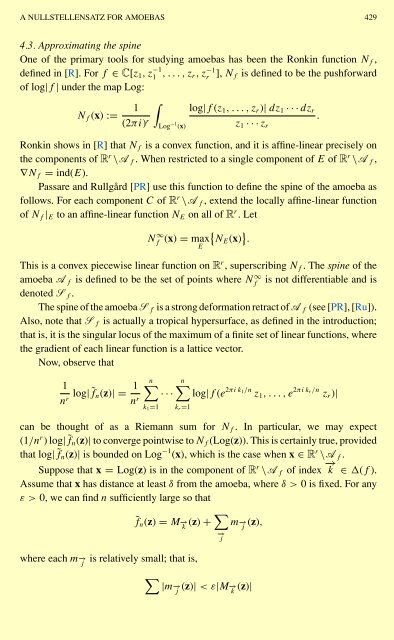A NULLSTELLENSATZ FOR AMOEBAS
A NULLSTELLENSATZ FOR AMOEBAS
A NULLSTELLENSATZ FOR AMOEBAS
You also want an ePaper? Increase the reach of your titles
YUMPU automatically turns print PDFs into web optimized ePapers that Google loves.
A <strong>NULLSTELLENSATZ</strong> <strong>FOR</strong> <strong>AMOEBAS</strong> 429<br />
4.3. Approximating the spine<br />
One of the primary tools for studying amoebas has been the Ronkin function N f ,<br />
defined in [R]. For f ∈ C[z 1 ,z −1<br />
1 ,...,z r,zr<br />
−1 ], N f is defined to be the pushforward<br />
of log|f | under the map Log:<br />
N f (x) := 1 log|f (z 1 ,...,z r )| dz 1 ···dz r<br />
.<br />
(2πi)<br />
∫Log r −1 (x) z 1 ···z r<br />
Ronkin shows in [R] thatN f is a convex function, and it is affine-linear precisely on<br />
the components of R r \A f . When restricted to a single component of E of R r \A f ,<br />
∇N f = ind(E).<br />
Passare and Rullgård [PR] use this function to define the spine of the amoeba as<br />
follows. For each component C of R r \A f , extend the locally affine-linear function<br />
of N f | E to an affine-linear function N E on all of R r .Let<br />
N ∞ f<br />
{<br />
(x) = max NE (x) } .<br />
E<br />
This is a convex piecewise linear function on R r , superscribing N f .Thespine of the<br />
amoeba A f is defined to be the set of points where Nf<br />
∞ is not differentiable and is<br />
denoted S f .<br />
The spine of the amoeba S f is a strong deformation retract of A f (see [PR], [Ru]).<br />
Also, note that S f is actually a tropical hypersurface, as defined in the introduction;<br />
that is, it is the singular locus of the maximum of a finite set of linear functions, where<br />
the gradient of each linear function is a lattice vector.<br />
Now, observe that<br />
1<br />
n r log| ˜f n (z)| = 1 n r<br />
n∑<br />
···<br />
k 1 =1<br />
n∑<br />
log|f (e 2πi k1/n z 1 ,...,e 2πi k r /n z r )|<br />
k r =1<br />
can be thought of as a Riemann sum for N f . In particular, we may expect<br />
(1/n r ) log| ˜f n (z)| to converge pointwise to N f (Log(z)). This is certainly true, provided<br />
that log| ˜f n (z)| is bounded on Log −1 (x), which is the case when x ∈ R r \A f .<br />
Suppose that x = Log(z) is in the component of R r \A f of index −→ k ∈ (f ).<br />
Assume that x has distance at least δ from the amoeba, where δ>0 is fixed. For any<br />
ε>0, we can find n sufficiently large so that<br />
˜f n (z) = M−→ k<br />
(z) + ∑ −→ j<br />
m−→ j<br />
(z),<br />
where each m−→ j<br />
is relatively small; that is,<br />
∑<br />
|m −→ j<br />
(z)|
















